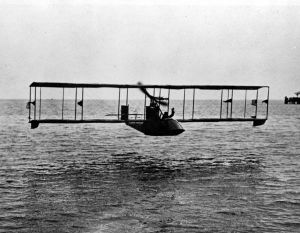Benoist Type XIV
| XIV | |
|---|---|
 |
|
| A Benoist XIV over Tampa Bay in Florida in 1914. | |
| Role | Airliner |
| Manufacturer | Benoist |
| Designer | Thomas W. Benoist |
| First flight | 1913 |
| Introduction | 1914 |
| Retired | 1914 |
| Primary user | St. Petersburg–Tampa Airboat Line |
| Number built | 2 |
The Benoist XIV was a small biplane flying boat built in the United States in 1913 in the hope of using it to carry paying passengers. The two examples built were used to provide the first heavier-than-air airline service anywhere in the world, and the first airline service of any kind at all in the United States.
The aircraft was a conventional biplane with equal-span unstaggered wings with small pontoons at their tips. The engine was mounted on a pedestal aft of the cockpit and drove a two-blade pusher propeller. Accommodation for the pilot and single passenger was side-by-side in an open cockpit.
The first example, given Benoist construction number 43 and named Lark of Duluth, carried joyriders over the harbour at Duluth, Minnesota through the Summer of 1913, but this was not a commercial success. The aircraft was wrecked once by Hugh Roberts, designer of the engine that powered the aircraft prior to competing in the Great Lakes Reliability Tour. The repairs and paint job left the aircraft with the partial name, "of Du". Later that year, Percival Fansler, a business associate of designer Thomas W. Benoist, convinced Benoist to join him in establishing a scheduled air service between the Florida cities of St Petersburg and Tampa. Their newly formed company, the St. Petersburg–Tampa Airboat Line purchased the Lark of Duluth and another Benoist XIV to inaugurate operations. The first scheduled flight between the two cities departed shortly before 10 AM on January 1, 1914 piloted by Tony Jannus and carried former St Petersburg mayor Abram C. Pheil as its passenger for the 22-mile (35-km) 23-minute flight. Regular tickets were priced at $5.00, but Phiel had paid $400.00 at auction for the ticket for the first crossing.
Over the next three months of the airline's short lifetime, the Lark of Duluth and her near-sister Florida (construction number 45) carried 1,205 passengers over Tampa Bay. At the end of March, however, the city subsidy ran out, and it proved no longer profitable to continue the service. The Lark of Duluth spent the remainder of 1914 carrying joyriders in several locations around the United States, including Duluth, Conneaut Lake, and San Diego. At this latter location it was damaged in a hard landing and pronounced unsalvageable.
...
Wikipedia
